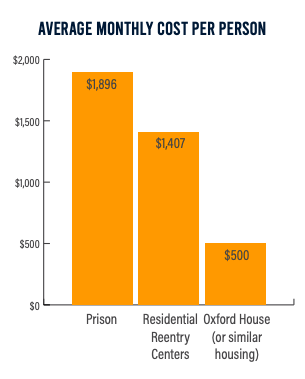Policy Background
People approved for parole who have no other housing options must wait in prison for months or even more than a year for an available bed in a residential reentry center (RRC). While Texas paroles approximately 28,000 people per year,1 it has approximately 2,000 state-funded RRC beds in eight facilities throughout the state, all operated by private prison corporations, including the GEO Group, CoreCivic, and Correctional Solutions Group.2
The annual cost to the state for these contracts is approximately $35 million;3 over and above that is the amount that Texas must pay to incarcerate individuals who remain in prison beyond their parole release date while awaiting an RRC bed. The state’s investment in these centers becomes more troubling when one considers that it could provide monthly housing stipends during the reentry period to more than double the number of people housed within RRCs.4
Not only do RRCs have long waiting periods, but they are widely known not to provide an environment conducive to successful reentry. For instance, because there are only eight facilities spread across seven Texas cities, it is unlikely that a person will be placed in a facility in or near their home community and support network. 
This presents challenges for returning individuals in finding employment: employers are aware that most people living in an RRC are unlikely to remain in the community for more than a few months,5 resulting in extreme delays in finding a job and earning enough income to move back to their home communities. When returning individuals are finally able to relocate to their home communities, they are then forced to repeat the reentry process a second time.
Other challenges with RRCs are as follows:
- Interviews with individuals previously residing in RRCs report a prison-like environment, including strip searches, limited movement, and restrictions that inhibit the ability of residents to find steady employment.6
- Many employers near the RRCs in Texas report not wanting to hire individuals from the facilities because residents are not allowed to leave the RRC for evening or weekend shifts.7
- Researchers evaluating the effectiveness of RRCs found patterns of indifference, misconduct, and under-training among staff. These factors resulted in violence, drug use/abuse, and overall dangerous environments for residents.8
- Private prison companies — such as the GEO Group and CoreCivic, the two major corporations in Texas — have lengthy track records of neglecting the basic needs of returning individuals and ultimately failing to provide a positive environment conducive to rehabilitation.9
Proposed Solution
Texas should rethink its investment in residential reentry centers. To achieve improved reentry outcomes at a lower cost to taxpayers, Texas leadership should:
1. Shift to a model that expands the use of housing vouchers at approved housing providers that meet standards established by the Legislature. This could double the amount of available housing at lower cost to the state than relying on RRCs.10 Collateral benefits include a stronger candidate pool for employers in additional Texas communities, and greater opportunities for success on reentry through more stable housing environments.
2. Allow people to move into recovery housing, such as Oxford House or similar evidence-based accountability-driven models, which are well known to support long-term recovery. Again, this would both save taxpayer dollars and improve reentry outcomes.11
Relevant Bills
- Bill Number: HB 2754 [Allen]
Bill Caption: Relating to post-release housing for inmates released on parole or to mandatory supervision.
TCJE Materials: Fact Sheet
- Bill Number: HB 2830 [White]
Bill Caption: Relating to post-release housing for inmates released on parole or to mandatory supervision.
- Bill Number: SB 1833 [Eckhardt]
Bill Caption: Relating to post-release housing for inmates released on parole or to mandatory supervision.
TCJEt Materials: Fact Sheet
In light of Texas’ projected budget crisis, TCJE developed 7 cost-saving solutions. Learn more about our ”Spend Your Values, Cut Your Losses" campaign here, and read the full portfolio of solutions here.
1 Texas Board of Pardons and Paroles, FY 2019 Annual Statistical Report.
2Directory - Residential Reentry Centers, Parole Division, TDCJ.
3 Data from the Texas Department of Criminal Justice, June 2020.
4 Costs were based on an estimated monthly housing voucher of $500 multiplied by 4,000, then by 12 months. The number of people the state could house through housing vouchers may be much higher when considering the variance in monthly rental costs by city.
5 Texas Center for Justice and Equity conducted interviews with individuals who had been placed in RRCs.
6 Kimberly Kras, Breanne Pleggenkuhle, and Beth Huebner, “A New Way of Doing Time on the Outside: Sex Offenders’ Pathways In and Out of a Transitional Housing Facility,” International Journal of Offender Therapy and Comparative Criminology, 60(5), 512–534 (2014).
7 Douglas Smith, personal interview with former resident of an RRC.
8 Derek Gilna, “When Halfway Houses Pose Full-Time Problems,” Prison Legal News, January 10, 2015. See also: Caroline Isaacs, “Denver Canceled Its For-Profit Reentry Contracts. Your City Should Be Next!” American Friends Service Committee – Arizona, August 8, 2019.
9 “How Private Prison Companies Increase Recidivism,” In the Public Interest, June 2016.
10 Cost calculations were determined as follows: Average monthly costs for prison incarceration were reported by the LBB Uniform Cost Report. Monthly costs per person at RRCs were reported by TDCJ through a data request received in June 2020. Average monthly cost of $500 for residency at Oxford House was reported in a 2015 Texas Oxford House Survey.
11 Leonard Jason and Joseph Ferrari, “Oxford House Recovery Homes: Characteristics and Effectiveness,” Psychological Services, 2010, Vol 7, No. 2, 92–102.
